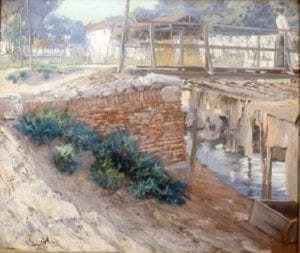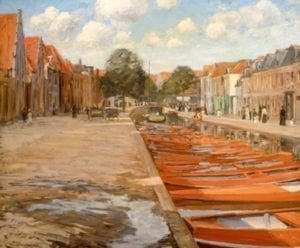Sally Metzler
Chicago, Illinois, United States
 |
| Frank Russell Wadsworth (1874-1905) A River Lavadero, 1905, Oil on canvas, Union League Club Chicago |
Though he basked in the Spanish sun, the summer warmth would be his downfall, indeed his early death. Artist Frank Russell Wadsworth of Chicago gravitated towards the vivid colors and picturesque river banks of Spain. He was but a mere thirty-one years of age when he died in 1905 in Madrid. One notice of his death states vaguely that he “was stricken with fever and died.”1 Another mentions he died of the “autumnal disease,” which often referred to dysentery. This euphemism was not so much the result of polite society, but that physicians believed outbreaks of dysentery appeared to rise during warmer months and abate by the winter. Thus it was appropriately named for its seasonal occurrence, accordingly “autumnal disease, or later “autumnal dysentery.”2
Dr. Andrew Wilson’s “An Essay on the Autumnal Dysentery,” from 1761 goes to extensive length describing the horrors of the affliction, the causes, and finally various treatments.3 In the late 1600s, physicians recommended bleeding in the arm and then administering an opiate (often laudanum), followed by a morning purging elixir. Suggested concoctions were boiled tamarinds, leaves of sena, and rhubarb, strained together with manna and syrup of roses—proscribed to be taken daily.4
In his book of 1809, Dr. Thomas Sydenham noted an increase of dysentery epidemics occurring in August, and gradual mollifying by winter, at which time smallpox became the problem.5 John Esten Cooke, Professor of Theory and Practice of medicine in Transylvania University, maintained in 1829 that moisture, heat, and the presence of vegetable matter were necessary for the production of dysentery (the same for diarrhea and cholera).6
Wadsworth’s father was a physician. Dr. Francis L. Wadsworth hailed from Oxford County, Maine, in 1833, and came to Chicago by 1853 to study at Rush Medical College. He remained in Chicago and built a successful career—adjunct professor at his alma mater Rush, professor of physiology and histology in the Woman’s Medical College, and physician in charge at St. Joseph’s Hospital.7
 |
| Frank Russell Wadsworth (1874-1905) Wharf of Red Boats, Haarlem, 1903 Oil on canvas, Union League Club Chicago |
Young Frank’s artistic inclinations likely came from his mother, Sarah F. Wadsworth, who was known to have painted during her travels abroad with her son. Frank began formal art training by the age of fourteen; he enrolled in the junior course at the School of the Art Institute, but stayed for only one month. After an eight-year hiatus, he returned to the School of the Art Institute, where over a short time he earned seven honorable mentions for his paintings.
A painting in the collection of the Union League Club of Chicago, A River Lavadero, records Wadsworth’s response to the Madrid environs, possibly the site where he was exposed to the humid and wet conditions that engendered his illness. Health risks aside, the painting proclaims the artistic bravura of Wadsworth. His deft brushwork and ability to capture atmospheric effects of sunlight on land and water are resplendent. Most striking, however, is that he elevated the common by his impressionistic sleight of hand. The sunny, impressionistic landscape depicts a laundry facility in Madrid; rows of white linen hang on the branches, while the river flows beneath. What in reality was a site of hard work and labor appears romanticized and even pretty under the spell of Wadsworth’s artistic touch. Human presence in the work is kept to a minimum. One woman crosses a bridge on the right and another woman, almost fully obscured by the laundry sheets, kneels at the river bank below.
During his later years, most of Wadsworth’s paintings reflect his time in Spain, but another work in the Union League Club of Chicago, Wharf with Red Boats, records a brief sojourn in Haarlem, the Netherlands. In 1903, he accompanied to Haarlem his mentor, the renowned artist William Merritt Chase, who was teaching there at the time. Wharf with Red Boats, as the River Lavadero, displays his hallmark impressionistic and spontaneous flair. He employs unusual viewpoints and perspectives, thereby adding another dimension of interest and depth to an otherwise quotidian scene. The deep red-orange color dominates the weathered boats and is echoed above on the roofs of the homes that line the Haarlem dock. After Haarlem, he returned to Spain and died in 1905. The art world and the city of Chicago soon after poignantly felt his absence:
“Mr. Wadsworth’s gardens and river vistas, with their gay color and eager, buoyant spirit, give a fresh poignancy to one’s regret for his early death.” [Chicago Examiner, Feb 10, 1906).
References
- Chicago Chronicle, Nov. 19, 1905.
- The term “autumnal disease” need not only refer to dysentery. Cooke, in his treatise, groups other afflictions under this category, such as intermittent and remittent fever, diarrhea, and cholera (see John Esten Cooke, Essays on the Autumnal and Winter Epidemics, Transylvania Press, 1829, p. 24). Typhoid and diphtheria can also rage during the autumn months, so one cannot exclusively assign autumnal disease to dysentery. In addition, autumnal disease seems to have been used to designate leptospirosis and even yellow fever. However, the prevalence of essays titled “autumnal dysentery” before Wadsworth’s death in 1905 indicates that the more general term “autumnal disease” pointed towards dysentery over the other diseases.
- Andrew Wilson, An Essay on the Autumnal Dysentery by a Physician, London, 1791,
- Works of Thomas Sydenham, MD, on Acute and Chronic Diseases with their Histories and Modes of cure, with notes by Benjamin Rush, MD, Prof of the Institute and Practice of Medicine, and of Clinical Practice, University of Pennsylvania, Philadelphia, 1809, p.112-113.
- See Works of Thomas Sydenham, MD, p. 105.
- See Cooke, p. 24.
- Dr. Francis H. Wadsworth died in August of 1891. A. T. Andreas, History of Chicago, from the earliest period to the present time. 3 vols. P. 537, vol. II (from 1857-until the fire of 1871), Chicago, 1885. P. 537
SALLY METZLER, Ph.D., is the Director of the Art Collection for the Union League Club Chicago.
Highlighted in Frontispiece Volume 9, Issue 4 – Fall 2017
Summer 2017 | Sections | Art Essays

Leave a Reply